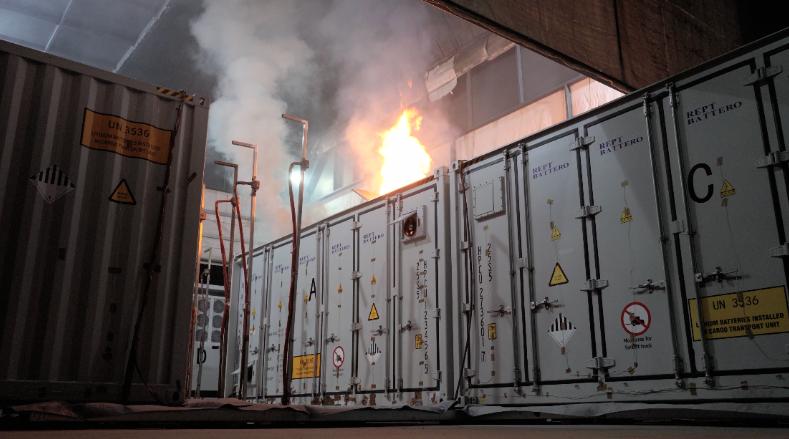
As global safety standards for energy storage intensify, REPT BATTERO has redefined product safety limits through an "extreme survival test." Witnessed by CSA Group, U.S. fire engineering auditors, and international clients, the company's Powtrix® 5MWh energy storage battery compartment recently passed a rigorous large-scale fire assessment. The fully charged unit burned continuously for 14 hours while successfully preventing thermal runaway propagation to adjacent equipment. This test replicated five complex fire scenarios, providing empirical validation of the product's safety performance.
Fire audit experts emphasized: "REPT BATTERO's test simulated worst-case fire conditions by integrating stringent protocols from CSA/ANSI C800:25, NFPA 855, and UL 9540A."
Testing a fully charged 5MWh battery compartment represents an exceptionally harsh scenario, where energy density and chemical reactivity peak. REPT BATTERO intentionally triggered thermal runaway under these conditions to validate passive safety systems.
The test initiated with 3+ hours of simultaneous internal heating and external propane flames (2,000℃), inducing self-sustaining combustion. During the 14-hour blaze, 5,000 batteries released 5MWh of energy while enduring five fire classes:
- Class A (solid materials)
- Class B (liquids/molten substances)
- Class C (gases)
- Class D (metals)
- Class E (live equipment)
Adjacent cabins sustained prolonged exposure to the inferno, challenging the system's worst-case fire resilience.
1. Ultra-Dense Configuration | 10cm Separation
Equipment was arranged in "shoulder-to-shoulder, back-to-back" quad-cabinet formation, with ≤10cm gaps between the ignition cabin (A), rear cabin (B), and side cabin (C). Despite this high-risk layout:
- Ignition cabin reached 1,380℃
- Adjacent cabin cells remained ≤57℃ (safe threshold)
Thermal runaway was fully contained, proving safety in space-constrained deployments.

2. Real-World Simulation | Fully Loaded Adjacent Cabin
The rear adjacent cabin was fully charged and operational during testing, replicating actual installation conditions and maximizing thermal stress on the most vulnerable equipment.
3. Fire System Deactivation | Passive Safety Validation
Fire suppression systems were deliberately disabled—only detection/alarm systems remained active. This confirmed the cabinet's intrinsic passive safety design can contain fires without external intervention. Notably, alarms functioned beyond required duration despite extreme conditions.
Composite Failure Simulation
The test combined:
- Internal multi-point heating
- External 2,000℃ flame jets
- "Bottom-up" ignition (increasing fire unpredictability)
This multi-hazard approach exceeded conventional single-factor tests by simulating thermoelectric coupling failures.
Comprehensive Data Collection
Over 600 temperature sensors, BMS analytics, and real-time gas monitoring provided granular performance data. The emissions management system minimized environmental impact, earning praise from U.S. fire safety auditors.
Post-test inspection verified:
Ignition Cabin: Complete cell combustion; structural integrity intact.
Adjacent Cabins: Undamaged internals; fully functional BMS.
Opposite Cabin: Soot discoloration only; batteries/BMS operational.
REPT BATTERO's test establishes a new safety paradigm for energy storage systems. By subjecting products to unprecedented extremes, the company demonstrates how robust passive safety design can prevent cascading failures—elevating reliability for the entire industry.
Next:None
Previous:Deep Dive into Ternary Lithium-Ion Batteries: Powering the Future of New Energy